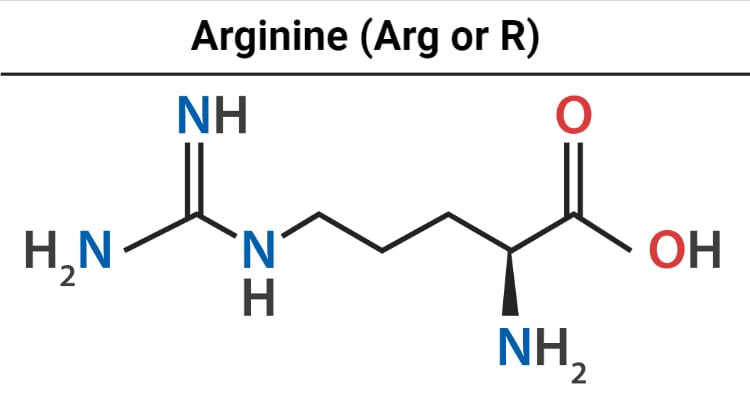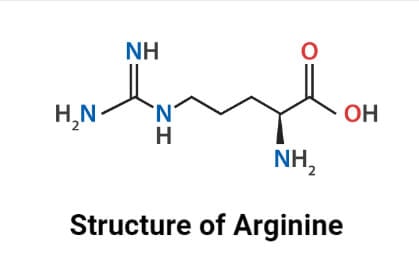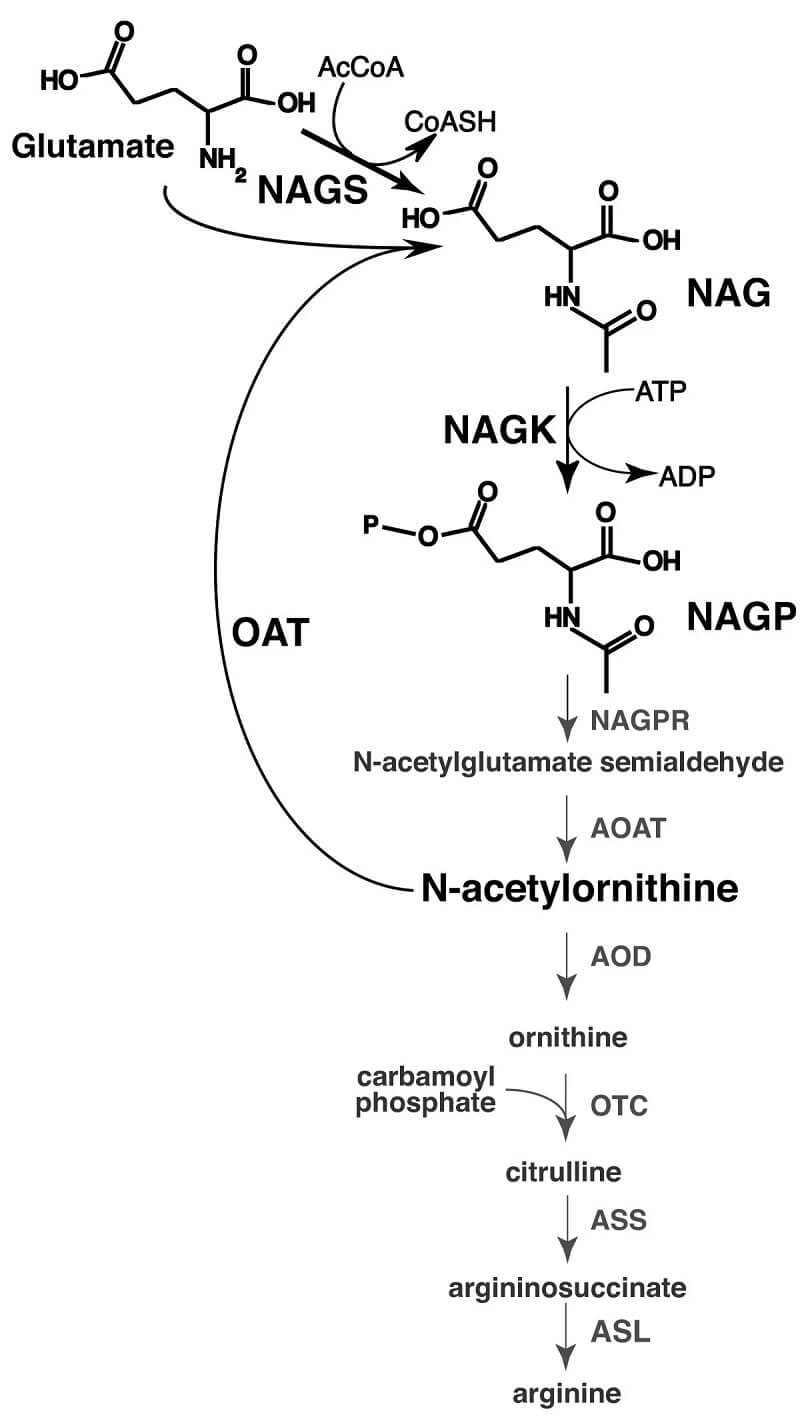
Arginine Definition
Arginine is also known as L-arginine is a semi-essential amino acid among 20 amino acids. It was first isolated by Schulze in 1886 from the lupin seedlings that are particularly abundant in protamines and histones. Arginine is abbreviated as Arg or R. It is a basic amino acid and can be synthesized by adults and not by growing children and hence referred to as semi-essential amino acids.
Arginine Structure
Arginine or 2-amino, 5- guanidinovaleric acid, has a molecular weight 174. 202. It contains α-amino group and α-carboxylic group and a side chain with 3- carbon aliphatic chain having guanidino group. Its molecular formula is C6H14N402. Arginine binds to the phosphate anion that is found in centers of proteins that binds phosphorylated substrates. Arginine has six codons in the genetic code. Arginine as a cation plays an important role in the overall charge balance of proteins. It has four nitrogen atoms per molecule so also called a nitrogen carrier in humans.

Sources
Within the body, the sources of arginine are dietary proteins, endogenous synthesis, and turnovers of body proteins.
- It is found in most protein-rich foods like fish, red meat, whole grains, beans, dairy products, and poultry.
- It can also be taken orally and intravenously.
Physical Properties
- White or almost white crystalline powder.
- Odorless
- Bitter in taste
- Polar
- Positively charged
- Anhydrous monoclinic plates from 66% alcohol.
- Contains two molecules of water.
Chemical Properties
- Melting point: 244ºC.
- Insoluble in ethyl ether
- Slightly soluble in ethanol
- Soluble in water
- Strongly alkaline
- pKa: 2.24 at 0ºC.
- Red color develops after the addition of alpha naphthol and sodium hypochlorite in the Sakaguchi test. This test is done for arginine.
Arginine Biosynthesis
L-arginine takes place in the enterocytes in some metabolism. L-arginine that is not metabolized in the enterocytes enters into the portal circulation from where it is transported to the liver. And again some portion of the amino acid is metabolized.

Figure: Arginine biosynthesis in microorganisms and plants. Image Source: Qiuhao Qu et al. 2007.
It can be synthesized from citrulline via ornithine through the breakdown of body proteins or from nitric oxide synthase. And can also be synthesized from proline and glutamate. The epithelial cells of the small intestine produce citrulline, which is then carried in the bloodstream to the cells of the kidney, which extracts citrulline from the circulation and convert it to arginine, which is then returned to the circulation. The three key regulatory enzymes of intestinal citrulline synthesis are Pyrroline-5-carboxylate (P5C) synthase, proline oxidase, and N-acetylglutamate (NAG) synthase. Citrulline is converted into Arginine in nearly all cell types, including adipocytes, endothelial cells, enterocytes, macrophages, neurons, and myocytes besides the kidney. Conversion of citrulline into arginine via argininosuccinate synthase and lyase is the only pathway inside cells for citrulline utilization. Most of the citrulline synthesized in enterocytes is converted locally into Arginine in most neonates.
Metabolic collaboration occurs in most de novo arginine synthesis between the small intestine and kidney that is known as the intestinal-renal axis of arginine synthesis. Arginine enters into the circulation that is derived from the body’s protein turnover at the time of fasting is 85%.
L-arginine is the precursor to nitric oxide. All tissues of the body produce nitric oxide and play a major role in the immune system, cardiovascular and nervous system. The enzyme nitric oxide synthase or synthetase, nitric oxide is formed from L-arginine and the effects are mediated by cyclic GMP or 3,5-cyclic guanylate. Enzyme guanylate cyclase is activated by nitric oxide that catalyzes the synthesis of cyclic GMP from guanosine triphosphate (GTP). Guanylic acid is formed by the enzyme cyclic GMP phosphodiesterase. NADPH, FAD, FMN, heme all are used by nitric oxide synthase. Ascorbic acid enhances the activity of nitric oxide by increasing tetrahydrobiopterin. With the increased concentration of calcium ions, nitric oxide is synthesized from eNOS and nNOS. Nitric oxide indicates that the Km of the enzyme for L-arginine. In endothelial cells or other cells, the concentration of L-arginine is found in the millimolar range. And under certain conditions, L-arginine saturates with nitric oxide and also enhances NO production.
Arginine Functions and Uses
- It helps the body in building protein.
- It helps in the development of T-cells and acts as a precursor for other amino acids like proline, glutamate, and creatine and the functioning of the immune system.
- It acts as a vasodilator as arginine is converted to nitric oxide in the body that causes blood vessels to open wider.
- It is also used to treat different heart conditions, preeclampsia, angina, and hypertension.
- It also stimulates the release of growth hormones and insulin.
- It can also be taken as a supplement for an athlete and also for wound healing, erectile dysfunction, etc.
- As arginine is an important amino acid, deficiency can disrupt cellular and organ function.
- Arginine also plays an important role in nitrogen metabolism and ammonia detoxification as an intermediate in the urea cycle.
Safety and Toxicity
- It is safe to use and generally lowers blood pressure.
- It can cause some side effects like bloating, diarrhea, stomach pain, and low blood pressure.
References
- Qu, Q., Morizono, H., Shi, D. et al. A novel bifunctional N-acetylglutamate synthase-kinase from Xanthomonas campestris that is closely related to mammalian N-acetylglutamate synthase. BMC Biochem 8, 4 (2007). https://doi.org/10.1186/1471-2091-8-4.
- Morris MS Jr (2006). Arginine: beyond protein. Am J Clin Nutr. 83: 508-512.
- Racke K and Warnken M (2010). L-Arginine metabolic pathways. The Open Nitric Oxide Journal. 2: 9-19.
- Satyanarayana U and Chakrapani U (2013). Biochemistry. Elsevier. Page: 43-48.
- Guoyao Wu, Fuller W. Bazer, A. Davis, Sung Woo Kim, Peng Li, J. Marc Rhoads, M. Carey Satterfield, Stephen B. Smith, Thomas E. Spencer, and Yulong Yin (2009). Arginine metabolism and nutrition in growth, health, and disease. Amino Acids. 37(1): 153–168.
- From, https://www.mayoclinic.org/drugs-supplements-l-arginine/art-20364681.
- From, https://www.webmd.com/vitamins/ai/ingredientmono-875/l-arginine.
- From, https://www.healthline.com/nutrition/l-arginine#benefits-uses.
- From, https://www.sciencedirect.com/topics/neuroscience/arginine.
- From, https://pubchem.ncbi.nlm.nih.gov/compound/Arginine.
- From, https://www.britannica.com/science/arginine.
- From, https://www.acs.org/content/acs/en/molecule-of-the-week/archive/a/l-arginine.html.
- From, http://www.biology.arizona.edu/biochemistry/problem_sets/aa/Arginine.html.
